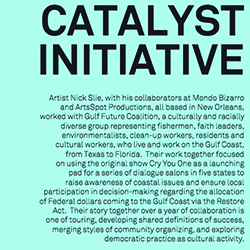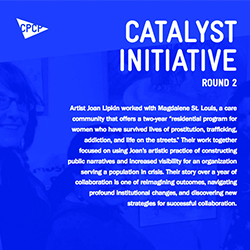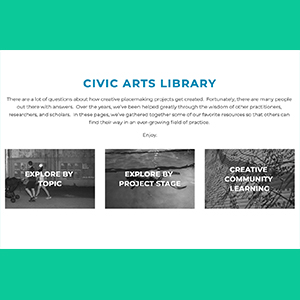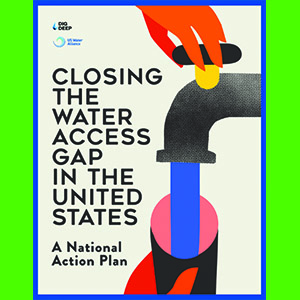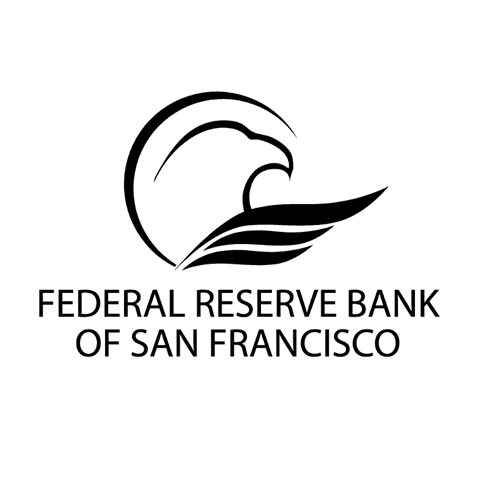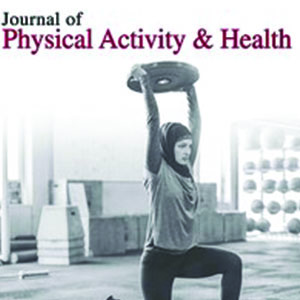CATALYST INITIATIVE: LOUISIANA
In this project, artist Nick Slie, with his collaborators at Mondo Bizarro and ArtsSpot Productions, all based in New Orleans, worked with Gulf Future Coalition, a culturally and racially diverse group representing fishermen, cultural workers, and more, who live and work on the Gulf Coast, from Texas to Florida. Their work together focused on using the original show Cry You One as a launching pad for a series of dialogue salons in five states to raise awareness of coastal issues and ensure local participation in decision-making regarding the allocation of Federal dollars coming to the Gulf Coast via the Restore Act.
291
CREATIVE CATALYST INITIATIVE: ST. LOUIS
Artist Joan Lipkin worked with Magdalene St. Louis, a care community that offers a two-year “residential program for women who have survived lives of prostitution, trafficking, addiction, and life on the streets.” Their work together focused on using Joan’s artistic practice of constructing public narratives and increased visibility for an organization serving a population in crisis. Their story over a year of collaboration is one of reimagining outcomes, navigating profound institutional changes, and discovering new strategies for successful collaboration.
CIVIC ARTS LIBRARY
In this resource hub, Civic Arts gathers together a number of creative placemaking resources from around the field and organizes them with a local government audience in mind. Resources can be found organized with descriptions by topic and project stage. This library also includes a compendium of webinars, blogs, and learning modules designed for the Engaging Local Government Leaders community and are free and available to the public. This resource is a “living library” and will continue to grow over time.
CLOSING THE WATER ACCESS GAP IN THE US: A NATIONAL ACTION PLAN
Over the last three years, the US Water Alliance has been on a journey to understand how water systems affect vulnerable people and to advance more equitable water management practices. We developed a national framework and produced the most comprehensive report to date on the water access challenge, using data analysis and on-the-ground research to understand the numbers and accelerate promising solutions. Through this research, they found that more than two million Americans live without access to running water, indoor plumbing, and safe sanitation. In response, we've crafted a four-part action plan to solve this challenge: Reimagine the Solution, Deploy Resources Strategically, Build Community Power, and Foster Creative Collaboration.
COMMUNITY DEVELOPMENT INNOVATION REVIEW: FEDERAL RESERVE BANK OF SAN FRANCISCO
This issue of the Community Development Innovation Review is dedicated to the topic of mental health and community development. It advances the healthy communities conversation by explicitly recognizing the relationship between mental health and physical health as well as the role social factors play in both aspects of overall wellbeing.
CREATING ACTIVITY-FRIENDLY COMMUNITIES: EXPLORING THE INTERSECTION OF PUBLIC HEALTH AND THE ARTS
Increasing physical activity in communities is a key public health strategy for chronic disease prevention and health promotion. Creating well-designed, activity-friendly communities requires partnerships beyond public health, and building community partnerships is an essential public health role. While public health leaders have been building coalitions with sectors such as transportation and land use to improve community health, many art practitioners and organizations are concurrently aligning their work with similar goals to improve quality of life in communities. Thus, the purpose of this commentary is to examine how public health can partner with the arts for community design efforts to increase physical activity.






